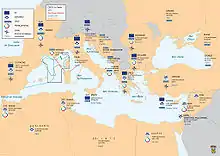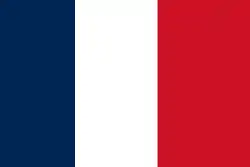Commander-in-Chief, Mediterranean (France)
The French Commander-in-Chief, Mediterranean, also known as CECMED (French for Commandant en chef pour la Méditerranée) is a French Armed Forces regional commander. He commands the zone, the region and the Mediterranean maritime arrondissements. He is usually an admiral of the French Navy, and is under the direct authority of the French Chief of the Defence Staff.[1] As of 2015 the position was held by Admiral Yann Tainguy.

| |||||||||||||||||||||||||||||
CECMED today is simultaneously:
- Commander of the région and the Mediterranean maritime arrondissement,
- Maritime Zone commander,
- Maritime Prefect for the Méditerranean.
Today the main French naval combat force in the Mediterranean is the Force d'action navale (FAN) headquartered at Toulon. The Admiral commanding the Naval Action Force (ALFAN) is responsible to the Chief of Staff of the French Navy at the rue Royale in Paris.
History
Mediterranean Squadron
Vice-amiral François Fournier was Commander-in-Chief, Mediterranean Squadron (Commandant en chef l'Escadre de Méditerranée) in January 1899 aboard Galilée.[2]
On 20 July 1921 after a series of designation changes, the force again became the Mediterranean Squadron.[3] It became the 1st Squadron on 1 January 1927; the Mediterranean Squadron on 30 October 1936; and the Mediterranean Fleet on 1 July 1939. On the outbreak of war the fleet consisted of the 2nd Squadron (Vice Amiral d'Escadre Emmanuel Ollive)[4] at Toulon, with three older battleships (including Bretagne and Provence) and their fleet torpedo boat escorts; the 3rd Squadron of two divisions of 10,000-ton cruisers (Algerie, Dupleix, Foch in 1e DC) and three divisions of contretorpilleurs, also at Toulon, and the 4th Squadron at Bizerte with a light cruiser division and three divisions of contretorpilleurs, under Rear Admiral André Marquis.[5]
In September 1939 the fleet included:[6]
- 2ème Escadre (VAE Ollive) : Provence (VAE Ollive - CV Barois)
- 2ème DL : Lorraine * (CA Vallée - CV Aurin) - Bretagne (CV Seguin)
- 1ère FT (CV Longaud) :
- 1ère DT : La Palme ° (CV Longaud) - Le Mars (CC Lamote) –Tempête (CC Pellegrin)
- 3ème DT : Le Fortuné ° (CC d’Hespel)– La Railleuse (CC Hourcade) – Simoun (CC Hainguerlot)
- 7ème DT : Tramontane ° (CF Renault) - Typhon (CC Le Hagre) – Tornade (CC Labat)
- 3ème Escadre (VA Duplat) :-
- 1ère Division de Croiseurs: Algérie *** (VA Duplat - CV Nouvel de la Flèche) - Dupleix (CV Hameury) – Foch (CV Mathieu) - Colbert (ship list as of 1 July 1939)[7]
- 2ème DC : Duquesne ** (CA Kerdudo – CV Husson) – Tourville (CV Marloy)
- 3ème EL (CA Derrien) :
- 5ème DCT : Tartu ° (CV Chomel) - Chevalier Paul (CF Bonnot) – Vauquelin (CF Jaujard)
- 7ème DCT : Vautour ° (CF Reboul Hector Berlioz) - Gerfaut (CF Penet) – Albatros (CF Penet)
- 9ème DCT : Maillé Brézé ** (CA Derrien) - CF Glotin) - Cassard (CF Braxmeyer) – Kersaint (CF Rebuffel)
- 4ème Escadre (CA Marquis) :
- 3ème DC : Marseillaise ** (CA Marquis – CV Hamon) - Jean de Vienne (CV Missoffe) – La Galissonniere (CV Dupré)
- Non endivisionné : Emile Bertin (CV Battet)
The twentieth century history of the French Navy in the Mediterranean includes surveillance of actions during the Spanish Civil War. On 14 June 1940, the 3rd Escadre executed Operation Samoyède. The squadron, including the cruisers Foch, Algérie, Dupleix and Colbert, bombarded Genoa, supported by French Naval Aviation.
In 1940, after the fall of France, the Royal Navy launched the attack on Mers-el-Kébir which disabled most of the French surface fleet in 1940 to prevent it from falling into German hands. In 1942 the scuttling of the French fleet in Toulon took place for the same reason. The Navy also protected troop convoys from French Algeria to France in both World Wars, and played a peripheral role in the Algerian War from 1954 to 1962. In 1956 the French Navy joined forces the Royal Navy to take control of the Suez Canal in Egypt during the Suez Crisis. In 1964, the cruiser Colbert became flagship of the Mediterranean squadron. The regional Mediterranean and Atlantic fleets (Amiral commandant l'escadre de la Méditerranée, ALESCMED, and Atlantic equivalent ALESCLANT), were replaced by ALFAN (the Naval Action Force) and Admiral, Antisubmarine Group (ALGASM) as part of Optimar '95, the post-Cold War restructuring process.[8]
Notes
- David Foxwell, 'France weighs up the global price, Jane's Navy International, July/August 1998, p.35
- http://ecole.nav.traditions.free.fr/ecoles_commandant_perrin.htm, accessed September 2011
- John Jordan, Jean Moulin, French Cruisers: 1922-1956, 2013
- Yann Vince, Guide historique des rues de Rezé, Nantes, Coiffard libraire éditeur, 2007 (ISBN 978-2-910366-77-3)
- On Seas Contested: The Seven Great Navies of the Second World War
- See also Jordan and Moulin, 2013, 174
- Jordan, John; Moulin, Jean (2013). French Cruisers: 1922-1956. Seaforth Publishing. p. 170. ISBN 1848321333.
- T.D. Young, Command in NATO after the Cold War, U.S. Army Strategic Studies Institute, Carlisle Barracks, 1997

